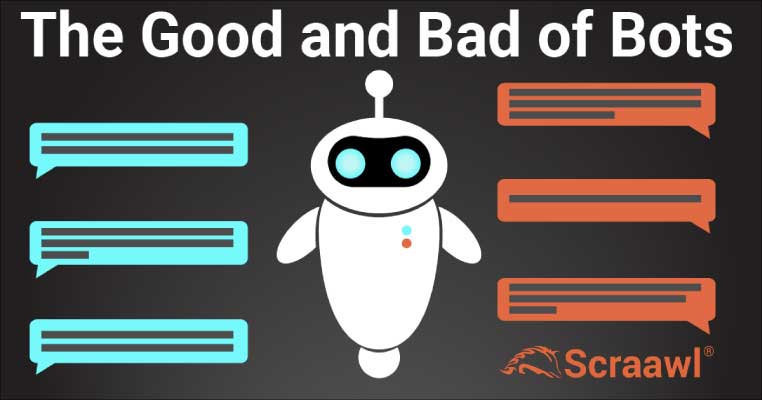Bots come in many flavors and with many different definitions. Simply put, bots run automated tasks, typically at a much higher rate than humans could. This high speed is often associated with malicious bots, such as click bots, spam bots, scrapper bots, spy bots, and zombie bots. These bots can impact website performance, skew data from ad views, compromise online account security, and infect at risk computers with malware and viruses.
In the context of social media, we often think of bots as the internet version of a gnat; they are pesky social media accounts that fill our feeds with promotional ads and clickbait. From a marketing perspective, bots can be even more troublesome, as they are often data corruptors. These non-human users can push out content far more rapidly than humans. This makes finding the human voice in the sea of bot-noise feel like searching for a needle in a haystack.
There are many examples of good bots, however, that are using advances in modern computer science to make users’ lives better. Copyright bots serve a critical role in preventing intellectual property theft. Data bots, which include virtual assistant tools such as the Amazon Echo, Google Home, Siri, and Cortana, provide frequent and up-to-date information tailored to the user. Chatbots are another example of how bot technology can perform positive actions. Chatbots are capable of providing an engaging and rapid customer service experience. Furthermore, with the advances of artificial intelligence and machine learning, bots are becoming more personal and are being developed to provide valuable interaction for users.
The Rise of the Bots
Intelligent chatbots can trace their origins back to the Turing Test published in 1950, which hypothesized that a machine can be considered to be able to think if a 3rd party observer cannot determine with accuracy a computer from a human in a text-based conversation. Although this test is highly contentious in the field of AI, it is widely credited as the starting point for exploration into chatbots and Natural Language Processing (NLP). The first successful bot to pass the Turing Test was ELIZA released in 1966. ELIZA searched dialogue for keywords which it used to identify relevant portions of a script for response. If no keywords were found ELIZA would respond with a generic answer.
Since the Turing Test and ELIZA, chatbots have transitioned from an experiment to a common occurrence across a variety of industries and use cases.

Image courtesy of WikiCommons – NASA Headquarters, Analog Computing Machine (https://bit.ly/2KwZTaD)
The Modern Realization
Business
Chatbots can be used to search efficiently for information in a database with conversational questions to help users find the information they desire. Similarly, chatbots can be used to simplify the ordering of goods. Furthermore, chatbots are extremely cost-effective compared to the manpower required to execute the same tasks manually. Companies are beginning to use chatbots to expedite the ordering and customer service processes without straining manpower or cutting into profits.
Ecommerce, especially, is welcoming the chatbot revolution with open arms. Domino’s Pizza has recently launched a pizza ordering chatbot named Dom. The new bot is simplifying the ordering experience by providing a tool over Facebook messenger. Dom does not require you to create an account before ordering, and instead collects all the necessary information through the dialogue prompts. Dom also allows you to reorder the last menu item you ordered through the chatbot for easy access to your favorites. Critics have noted the limitations of the current chatbot, especially its lack of convenient payment methods. Despite these issues, the chatbot Dom is still being heralded as a major development in ecommerce technologies. Domino’s leadership has commented that it hopes Dom will alleviate strain on their phone lines and website during high volume ordering periods.

Entertainment
Bots are also being explored as a means of creating an immersive entertainment experience. Disney has developed a crime-solving bot using the characters of the animated film Zootopia. Marvel has also explored these interactive entertainment opportunities, developing two chatbots. One bot allows you to chat with Star-Lord from Guardians of the Galaxy and the other enables you to have a conversation with Spiderman. Marvel has taken these two bots to the next level by integrating full-color artwork from marvel comics.

Quality of Life
Chatbots are also building the foundation for advanced virtual assistants. One of the most unique use cases for a chatbot that is currently being researched is a conversational partner and cognitive monitoring system for patients with dementia.
BlueHalo, Scraawl’s parent company, is developing a chatbot to help cancer patients monitor and report radiation treatment symptoms. The mobile patient-reported outcomes (mPRO) will prompt patients with questions about expected symptoms, and report all noted symptoms to their doctor. The chatbot will ask questions of the patient such as “do you feel dizzy?” or “is your mouth feeling dry today?” The chatbot will be designed to engage patients in a relaxed conversation about their symptoms and will provide emotional reassurance and self-care suggestions. For more information on BlueHalo’s chatbot capabilities, and to find out how we can develop a custom solution for you please contact contact@scraawl.com.
A Look to the Future
Natural Language Processing (NLP) appears to be the future of chatbots and virtual assistant tools. NLP is a blend of computer science, artificial intelligence, and linguistics. Ideally, natural language processing attempts to understand human language.
Natural Language Processing is closely tied with the field of deep learning which takes a multi-level approach to processing data. In NLP there is typically an input phase, in which an audio file is created or a text file is provided to the system. This phase is followed by a processing phase in which the data is formatted to be usable. The processing phase is often followed by one or more linguistic analysis phases including morphological, syntactic, and semantic analysis.
As Natural Language Processing matures, we can expect that chatbots will explode in quantity and usability to an even greater extent than they currently exist.




